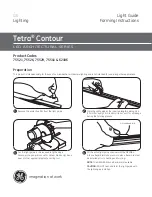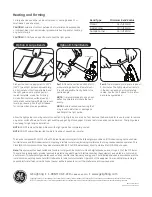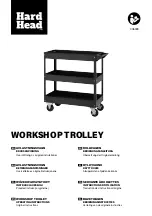
ARCH018-R100213
GEH-5989 35-201578-181
Heating and Forming
Part 1: Move the section back and forth
while rotating about the diameter until
it is soft and pliable. Gently bend to the
desired angle.
NOTE:
It is recommended to use a heat-
deflecting shield to distribute the heat
evenly.
NOTE:
Avoid localized overheating that
may result in distortion or damage (i.e.
bubbling) of the light guide.
For large bends, use either an industrial oven or heating blanket. For
small bends, use a heat gun.
CAUTION:
Avoid direct contact between hot materials and exposed skin
or combustibles. Use heat resistant gloves while heating and/or handling
any hot materials.
CAUTION:
DO NOT use an open flame to heat the light guide.
Part 2: The workable forming time is about
2–3 minutes. The light guide must remain
in the desired position until completely
cooled. See the chart above for minimum
bend radius guidelines.
Allow the light guide to cool by natural convection or lightly forced cool air (i.e. fan). Remove the Bend-Aids for reuse. In order to remove
any minor surface flaws, perform a light sanding using 400 grit sandpaper. Flared or deformed ends can be trimmed. The light guide is
now ready for light engine installation.
NOTE:
DO NOT remove the Bend-Aids until the light guide has completely cooled.
NOTE:
DO NOT subject heated light guide to freezing or quenching in water.
Heat gun
Preheat the heating equipment to 300°F
(149°C). Heat light guides approximately
6-15 minutes until soft and pliable. Bend
the light guide over a printed pattern,
routed template, or use free-forming.
A clean flat insulated surface (wood or
laminated countertop) will help to prevent
twisting or bowing. See the chart above
for minimum bend radius guidelines.
Option B: Small Bends
Option A: Large Bends
Planar
0.5 in. (13mm)
Inside Corner
1.0 in. (25mm)
Outside Corner
1.5 in. (38mm)
Bend Type
Minimum Bend Radius
This device complies with Part 15 of the FCC Rules. Operation is subject to the following two conditions: (1) This device may not cause harm-
ful interference, and (2) this device must accept any interference received, including interference that may cause undesired operation. This
Class [A] RFLD complies with the Canadian standard ICES-003. Ce DEFR de la classe [ A ] est conforme á la NMB-003 du Canada.
Note:
This equipment has been tested and found to comply with the limits for a Class A digital device, pursuant to part 15 of the FCC Rules.
These limits are designed to provide reasonable protection against harmful interference when the equipment is operated in a commercial
environment. This equipment generates, uses, and can radiate radio frequency energy and, if not installed and used in accordance with the
instruction manual, may cause harmful interference to radio communications. Operation of this equipment in a residential area is likely to
cause harmful interference in which case the user will be required to correct the interference at his own expense.
(1- 888 - 69 - 43-533)
GE Lighting • 1-888-MY-GE-LED
GE Lighting Solutions, LLC is a subsidiary of the General Electric Company. Tetra is a trademark of GE Lighting. The GE brand and logo are trademarks of the General Electric Company.
© 2013 GE Lighting Solutions, LLC. Information provided is subject to change without notice. All values are design or typical values when measured under laboratory conditions.
• www.gelighting.com




















